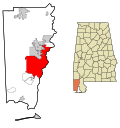Saint Paul's Episcopal Chapel | |
 Saint Paul's Episcopal Chapel in 2008. | |
| Location | Mobile, Alabama |
|---|---|
| Coordinates | 30°41′53″N88°8′21″W / 30.69806°N 88.13917°W |
| Built | 1859 |
| Architectural style | Late Victorian, Gothic Revival |
| MPS | 19th Century Spring Hill Neighborhood TR |
| NRHP reference No. | 84000123 [1] |
| Added to NRHP | October 18, 1984 |
Saint Paul's Episcopal Chapel is a historic Episcopal church building in Mobile, Alabama, United States. It was built in 1859 in a vernacular Gothic Revival style. [2] The building was placed on the National Register of Historic Places as a part of the 19th Century Spring Hill Neighborhood Thematic Resource on October 18, 1984. [1]





